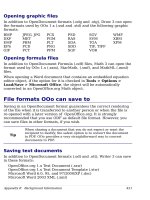Getting Started with Open Office .org 3 part 29 pot
Bạn đang xem bản rút gọn của tài liệu. Xem và tải ngay bản đầy đủ của tài liệu tại đây (4.77 MB, 10 trang )
Using data sources in OOo documents
Data can be placed into Writer and Calc documents from the tables in
the data source window. In Writer, values from individual fields can be
inserted. Or, a complete table can be created in the Writer document.
One common way to use a data source is to perform a mail merge.
Tip
Selecting Tools > Mail Merge Wizard or clicking on the Mail
Merge icon (a small paper-and-envelope icon on the View Data
Source pane) launches the Mail Merge wizard which steps
through creating a mail merge document. This is discussed in
Chapter 11 (“Using Mail Merge”) in the Writer Guide.
Writer documents
To insert a field from a table opened in the data source window into a
Writer document , click on the field name (the gray square at the top of
the field list) and, with the left mouse button held down, drag the field
onto the document. In a Writer document, it will appear as <FIELD>
(where FIELD is the name of the field you dragged).
For example: enter the cost of meals and who paid for them on a
certain date of a vacation. Make a sentence of this data: “On (date),
our breakfast cost (amount) paid by (name), our lunch cost (amount)
paid by (name), and our supper cost (amount) paid by (name). Write
the words of the sentence with the exception of the words in
parentheses. Use the correct field names in the place of the words in
parentheses.
1) Replacing (data)
• Begin the sentence by typing the word
On
.
• Click the field name Data in the data source window and drag
it to the right of the word
On
.
• The sentence becomes: On <Date>. If you have Field shadings
turned on (View > Field shading), <Date> has a gray
background. Otherwise it does not.
2) Replacing first (amount)
• Continue typing after <Date>:
our breakfast cost
.
• Click the Breakfast field name and drag it to the right of what
you have just typed.
• Make sure you have the proper spacing between the field
names and the words before and after them.
• Results so far: On <Date> our breakfast cost <Breakfast>,
Chapter 8 Getting Started with Base 281
3) Replacing the first name:
• Continue typing after <Breakfast>:
paid by
making sure to
add a space afterward.
• Click the Bpayment field name and drag it to the right of what
you just typed.
• Place a comma after <Bpayment>.
• Results so far: On <Date> our breakfast cost <Breakfast>
paid by <BPayment>,
4) Follow these examples to fill in the rest of the fields in the
sentence.
• Use <Lunch> and <Lpayment> for the second set of (amount)
and (name) in the sentence.
• Use <Supper> and <Spayment> for the third set of (amount)
and (name) in th sentence.
• Final results: On <Date> our breakfast cost <Breakfast> paid
by <BPayment>, our lunch cost <Lunch> paid by
<LPayment>, our supper cost <Supper> paid by
<SPayment>.
5) Add data to the fields of the sentence:
• Click the gray box to the left of the row of data you want to
add. That row should be highlighted like the second row of
Figure 61.
• Click the
Data to Fields
icon (circled in black in Figure
61).This should fill the fields with the data from the row you
chose.
• Click another row and then click this icon again. The data in
the sentence changes to this selected row of data.
• Save the document.
Adding data in table format is a little easier and takes perhaps a few
less steps. Some of the steps will be quite similar.
Note
Data can be added this way as a fields or text. Following the
following steps. I leave this to the reader with which to
experiment by changing the selections in the
Insert Database
Columns
to see what results you can get.
282 Getting Started with OpenOffice.org 3
Figure 235: Selected row in data source window
1) Navigate to the place you want to place the table and click the
location.
2) Click the gray box to the left of each row of the data source that
you want to be a row in your table.
3) Click the
Data to text
icon to open the Insert Database Columns
dialog (Figure 236). (The
Data to text
icon is circled in red in
Figure 235.)
Figure 236: Insert Database Columns dialog
4) Move the fields you want in your table from the
Database
Columns
list to the
Table column(s)
list.
• To place the fields in the order you select, click the field and
use the
single arrow
to move the fields in the order you desire.
You can also limit the fields you use to less than all of the
fields available.
• If you want to use all of the fields, use the
double arrow
pointing to the right to move all of them at one time. The
order of the fields in the table you create will be the same as
in the data source table.
• If you want to remove a single field from the
Table Column(s)
list, click the field and use the
single arrow
pointing to the
left.
• If you want to start over by moving all of the fields back to the
Database Columns
list, click the
double arrow
pointing to the
left.
Chapter 8 Getting Started with Base 283
5) Select the settings for your table. Use the default settings as in
Figure 236.
6) Click OK.
7) Save the document.
Calc spreadsheets
There are two ways to enter data in a Calc spreadsheet. One enters the
data into the spreadsheet cells. The other creates records in the
spreadsheet just like they are done in creating a form in a database.
While you can directly access the data in the spreadsheet cells, you can
only see the data in the records created in the spreadsheet.
Entering data directly to the spreadsheet cells uses the
Data to Text
icon as we did to make a table in a Writer document. But differences
exist in these two situations.
The steps are straightforward.
1) Click the cell of the spreadsheet which you want to be the top left
of your data including the column names.
2) Use F4 to open the database source window and select the table
whose data you want to use.
3) Select the rows of data you want to add to the spreadsheet:
• Click the gray box to the left of the row you want to select if
only selecting one row. That row is highlighted.
• To select multiple rows, hold down the
shift
key while clicking
the gray box of the rows you need. Those rows are
highlighted.
• To select all the rows, click the gray box in the upper left
corner. All rows are highlighted.
4) Click the
Data to text
icon to insert the data into the spreadsheet
cells.
5) Save the spreadsheet.
Adding records to a spreadsheet is fairly easy. You need to have the
D
ata Source
window open, your spreadsheet open, and the table you
want to use selected.
1) Click the gray box above the field name you wish to use to
highlight it.
2) Drop and drag the gray box to where you want the record to
appear in the spreadsheet.
3) Repeat until you have moved all of the fields you need to where
you want them.
284 Getting Started with OpenOffice.org 3
4) Close the Data Source window: use
F4
.
5) Save the spreadsheet and click the
Edit File
button to make the
spreadsheet read only. All of the fields will show the value for the
data of the first record you selected.
6) Add the
Form Navigation
toolbar: View > Toolbars > Form
Navigation.
Figure 237: Navigation arrows of a form
7) Click the arrows on the Form Navigation toolbar to view the
different records of the table. (The arrows are circled in red.) The
number in the box changes when you change the record number
by clicking an arrow. The data in the fields changes
correspondingly to the data for that particular record number.
Entering data in a form
Records
are used to organize the data we enter into a form. They also
organize the data we enter into a subform (Figure 238).
Figure 238: Single Record
Each type of field allows a different method to enter the data. In most
if not all cases, more than one method can be used.
Chapter 8 Getting Started with Base 285
The first step to entering data in a form is to open it from the main
database window.
1) Click the Forms icon in the
Database
list.
2) Find the form’s name in the
Forms
list (Vacations).
3) Double-click the form’s name.
The quickest way to enter a date in the Date field is to click the arrow
that opens the dropdown calendar. Then click the day the you want
(Figure 239). To change the month use the following steps. Then use
the
Tab
key to go to the Odometer field.
• Click the left arrow before September to go back one month
(August 2008).
• Click the right arrow after 2008 to go forward one month
(October 2008).
• Multiple clicks in either direction will change the month the same
number of times as the number of clicks. (The year also changes
as you move from January back to December or December
forward to January each time.)
Figure 239: Calendar dropdown
The Odometer, Tolls, and Motel fields are numerical fields. Enter
values directly into them, or use the
up
and
down arrows
. When the
value is entered, use the
Tab
key to go to the next field.
• Clicking the
up arrow
increases the value, and the
down arrow
decreases the value one unit.
• These two arrows only change the numerals to the left of the
decimal place.
• Numerals to the right of the decimal place must be changed by
deleting them and typing the desired ones.
The Motel's Payment field is a dropdown list. If as in my case, all of the
elements of the list start with different letters, typing the first letter
selects the desired letter.
286 Getting Started with OpenOffice.org 3
• If two or more elements of the list have the same first letter,
repeated typing of the first letter will cycle through the elements
with this same first letter. So, if you accidentally go past the the
element you wanted, you can keep typing the first letter until it
reappears again.
• When the selection is correct, use the
Tab
key to go to the Misc.
field.
The rest of the fields of the main form are either numerical fields or
dropdown lists until we reach the Misc. Notes field. It is a text field.
Type anything you desire in this field just as you would any simple text
editor.
Caution
Since the
Tab
key is used to move between fields, it can not be
used in a text field. All spacing must be done by the
spacebar
.
Finally, the
Enter
key only acts as a line break to move the
cursor to the next line. While the
Enter
key will move from non-
text fields to non-text fields, it will not do so from a text field.
Use the
Tab
instead.
Note
If we did not have a subform for fuel data, using the
Tab
key in
the last field would save all of the fields, clear them, and make
the form ready to accept data on the second record.
Since we have a subform form, using the
Tab
key places the cursor in
the first Date field of the subform with the date automatically entered
to match the Date field of the main form.
The FuelCost, FuelQuantity, and Odometer fields are numerical fields.
The Payment field is a dropdown list. Enter the data just as you did in
the main form, and use the
Tab
key to go to the next field.
When you use the
Tab
key to leave the Payment field, it goes to the
Date field of the next line and automatically enters the date. Now you
can enter your second set of fuel data for this day.
To move to another record when the form has a subform, click any of
the fields of the main form. In this case, click the Date field of the main
form. Then use the directional arrows at the bottom. There are four of
them from left to right:
First Record, Previous Record, Next Record
,
and
Last Record
(Figure 237). To the right of these arrows is the
New
Record
icon.
To create a new record while in another record in the main form, use
one of these choices:
• Click the
Next Record
icon.
Chapter 8 Getting Started with Base 287
• Or, click the
New Record
icon.
Tip
The number in the Record box is the number of the record whose
data is shown in the form. (The data from the second record of
the Vacations form was displayed when I took the screenshot for
Figure 240.)
If you know the number of the record you want, you can enter it
into the record box and then use the
Enter
key to take you to
that record.
Figure 240 is a record with data inserted in its fields. Note that not all
fields have data in them. It is only necessary to have data in every field
if you determine ahead of time to require all fields contain data.
Caution
If you required data be entered for a particular field and you do
not have data for that field, you can no longer create a new
record. You have to edit the table containing that field and
change the
Entry Required
. Save the table
and
the database.
This could also cause you to lose data in the particular field.
Figure 240: Sample record of the Vacation form and subform
Creating queries
Queries are used to get specific information from a database. Using
our CD-Collection table, we will create a list of albums by a particular
artist. We will do this using the Wizard. The information we might want
288 Getting Started with OpenOffice.org 3
from the Fuel table includes what our fuel economy is. We will do this
using the Design View.
Note
Queries blur the differences between a database and a data
source. A database is only one type of data source. However,
searching for usable information from a data source requires a
query. Since the query (one part of a database) does this, the
data source appears to become one part of that database: its
table or tables. Query results, themselves, are special tables
within the database.
Using the Wizard to create a query
Queries created by the wizard provide a list or lists of information
based upon what one wants to know. It is possible to obtain a single
answer or multiple answers, depending upon the circumstances.
Queries which require calculations are best created with the Design
view.
In the main database window (Figure 176), click the Queries icon in
the Databases section, then in the Tasks section, click
Use Wizard to
Create Query
. The Query Wizard window opens (Figure 241). The
information we want is what albums are by a certain musical group or
individual (the album’s author). We can include when each album was
bought.
Figure 241: First page of the Query Wizard
Chapter 8 Getting Started with Base 289
Note
When working with a query, more than one table can be used.
Since different tables may contain the same field names, the
format for naming fields in a query is Table name and field name.
A period (.) is placed between the table name and the field name.
For example, The Lunch field of the Vacation table used in a
query has the name
Vacation.Lunch
.
Step 1: Select the fields.
1) Select the CD-Collection table from the dropdown list of tables.
• If the Tables selection is not
Table: CD-Collection
, click the
arrow (circled in red in Figure 241).
• Click
Table: CD-Collection
in the list to select it.
2) Select fields from the CD-Collection table in the
Available fields
list.
a) Click
AlbumTitle
, and use the > button (black oval in Figure
241) to move it to the
Fields in Query
list.
b) Move the Artist and DatePurchased fields in the same manner.
c) Use the up arrow to change the order of the fields: artist,
album, and date purchased.
• Click the
CD-Collection.Artist
field.
• Click the up arrow to move it above
CD-
Collection.AlbumTitle.
d) Click Next.
Tip
To change the order of the fields, select the field you want to
move and click the up or down arrow to move it up or down
(circled in magenta in Figure 241).
Figure 242: List of fields added to the query
Step 2: Select the sorting order.
Up to four fields can be used to sort the information of our query. A
little simple logic helps at this point. Which field is most important?
290 Getting Started with OpenOffice.org 3









